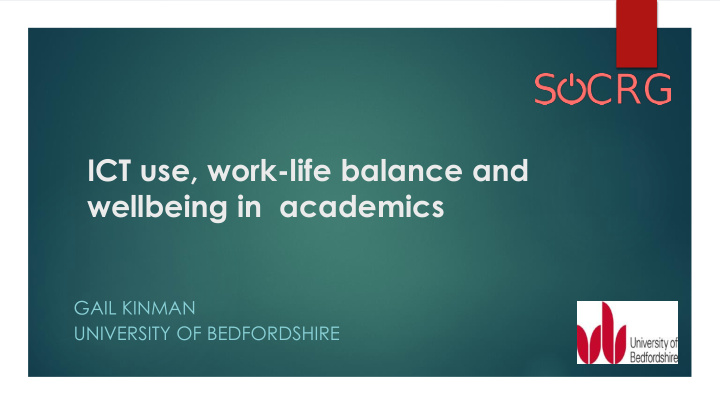



ICT use, work-life balance and wellbeing in academics GAIL KINMAN UNIVERSITY OF BEDFORDSHIRE
Work-related wellbeing in academics Rising demands; increasing pressure; reduced control and manager support (2008 – 2014) Role overload/conflict and illegitimate tasks Comparatively high levels of burnout and distress Problems maintaining a “healthy” work -life balance Work-life conflict increasing; facilitation decreasing Sources: Kinman & Wray, 2015; Kinman, 2015; Watts & Robertson, Linked to high demands/low support/long hours 2010; Winefield et al. 2014
Academics: flexibility and ICT Job control and schedule flexibility can help accommodate the competing demands of work and personal life High job involvement; preference for work-life integration ICT can facilitate boundary management and improve WLB and role performance in each domain BUT, risk that ICT can “enable” intensification high demands + schedule flexibility + job involvement can Source: Kinman & Jones, 2009; threaten recovery and WLB Kelliher, 2010
Academics and e-mail Some evidence that academics frequently access email during evenings, weekends and holidays Growing evidence for e-mail overload - a source of stress and a threat to job performance Some e-mail management initiatives developed in other sectors Little guidance on “healthy” and “unhealthy” e -mail Sources: Kinman & Jones, 2004; use in HE – reliance on self regulation Pignata et al. 2015; Hadlington, 2015
Aims and method To explore academics’ use of ICT for work and the implications for recovery, WLB, wellbeing and personal/professional functioning Mixed methods: online survey (n = 322) and interviews (n = 30) Measures: Job demands, control and support Schedule flexibility; integration preference; job involvement; e-mail behaviours Affective rumination; work-life conflict; emotional exhaustion; role performance Interviews explored issues in greater depth + other related factors
Findings: e-mail use and impact Accessing work e- mails outside “office hours” is customary practice Reasons: workload pressure; demands for prompt response; expectations of others; short staffing; job involvement/interest; habit and personal choice Some ambivalence found: Risks Benefits High email overload, linked to E-mail seen as a potential enabler rumination and time/strain based WLC of flexibility across time and place and EE; source of distraction; can and of work-life balance; impair role performance across potential to improve domains and impair relationships performance (volume and quality); facilitates work at time of choosing
Academics and e-mail - some observations “No choice – too “ Sneaking off to the loo “Students contacting me at 10pm asking for much to do – it will to read my emails on feedback or for an appointment the next day – all pile up otherwise” we have to keep them happy” holiday” “Because I work with people “My partner is also “Making contracts who have different expectations an academic and with family (and of “personal life” is always checking myself) about “We all put on his email – I feel I accessing emails at ‘out of office’ have to do it too “My choice –– it allows me set times” notifications but and then we start to work from home and fit read our emails talking how much more research in” anyway nobody we resent it!” takes any notice “No emails after 6 or at “I prefer to spend some though” weekends and holidays. time each day keeping It can irritate colleagues the volume down” and students though”
E-mail behaviours and preferences More schedule flexibility, work-life integration and job involvement = more frequent e-mail use Preference for work-life integration moderated the negative impact of e-mail, but poorer WLB Satisfaction gained in tackling e-mails, but short- term only “A Sisyphean task” – as an empty in-box is quickly replenished
E-mail management Few used e-mail management strategies, but the need to develop more healthy behaviours acknowledged Little guidance available (apart from e-working policy) Mixed views of formal e-mail management initiatives Many lacked control, but reluctant to have changes “imposed” High expectations of self management (often in the face of previous failure); self blame E-mail use shaped by the expectations of others and the behaviours of colleagues – importance of role modelling
Conclusions: E-mail overload underpinned by many factors relating to workload pressure, working conditions, culture, behaviours and expectations E-mail facilitates flexibility, but some respite required to sustain wellbeing, WLB and performance – long-term problems? Some variation in attitudes towards e-mail management Creative strategies needed - resistance to “one -size-fits- all” interventions in the face of work centrality, integration preferences and high expectations of control
Recommend
More recommend